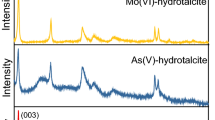Abstract
The aqueous solubility of Fe2(SeO3)3·6H2O(c) was studied in deionized water adjusted to a range in pH values from 0.77 to 5.1 and in Na2SeO3 solutions ranging in concentrations from 0.0002 to 0.02 mol-dm−3. The studies were conducted from both the undersaturation and oversaturation directions, with equilibration periods ranging from 7 to 1725 days. Stoichiometric dissolution of the solid was observed in solutions with pH values up to nearly 4. In general, concentrations of both Se and Fe decreased as pH increased from 1 to 4. Analyses of the equilibrated suspensions confirmed the equilibrium solid to be Fe2(SeO3)3·6H2O(c) and the aqueous Se to be selenite. Pitzer's ion-interaction model was used with selected ion pairs to interpret the solubility data. The logarithm of the solubility product of ferric selenite
was found to be −41.58±0.11. This value is less than any reported in the literature for a ferric selenite by more than 10 orders of magnitude. The solubility data and calculations show an extremely strong interaction between aqueous Fe3+ and SeO 2−3 ; interpretation of these data requires the inclusion of FeSeO +3 i.e.
Similar content being viewed by others
References
J. H. Howard, Ph.D. Dissertation, Standford University, California, 1969.
P. J. Duns, D. R. Pecker, and B. Darko Sturman,Canadian Mineralogist 16, 605 (1978).
D. Rai, S. V. Mattigod, and D. A. Moore,Mat. Res. Bull. 23, 1621 (1988).
V. G. Chukhlantsev and G. P. Tomashevsky,J. Anal. Chem. USSR 12, 303 (1957).
D. Rai, R. J. Serne, and D. A. Moore,Soil. Sci. Soc. Am. J. 44, 490 (1980).
D. Rai, A. R. Felmy, and D. A. Moore,J. Solution Chem. 20, 1169 (1991).
G. B. Naumov, B. N. Ryzenko, and I. L. Khodakovsky,Handbook of Thermodynamic Data NTIS PB 226-722, (National Technical Information Service, Springfield, Virginia, 1974).
L. G. Sillen, and A. E. Martell,Stability Constants of Metal-Ion Complexes Special Publication No. 17, (Chemical Society, London, 1964).
J. H. Howard III,Geochim. Cosmochim. Acta 41, 1665 (1977).
H. R. Geering, E. E. Cary, L. H. P. Jones, and W. H. Allaway,Soil Sci. Soc. Am. Proc. 32, 35 (1968).
M. A. Elrashidi, D. C. Adriano, S. M. Workman, and W. L. Lindsay,Soil Sci. 144, 141 (1987).
D. Rai, J. M. Zachara, A. P. Schwab, R. L. Schmidt, D. C. Girvin, and J. E. Rogers,Chemical Attenuation Rates, Coefficients, and Constants in Leachate Migration, Vol. 1, “A Critical Review” EPRI EA-3356, (Electric Power Research Institute, Palo Alto, California, 1984).
S. Hamada, Y. Ishikawa, and T. Shirai,J. Chem. Soc. Japan 86, 1042 (1965). (Quoted by Sillen and Martell in Ref. 15).
L. G. Sillen and A. E. Martell,Stability Constants of Metal-Ion Complexes Supplement No. 1, Special Publication No. 25, (Chemical Society, London, 1971).
R. M. Smith and A. E. Martell,Critical Stability Constants, Vol. 4, “Inorganic Complexes”, (Plenum Press, New York, 1976).
D. Rai,Radiochim. Acta 35, 97 (1984).
A. R. Felmy, GMIN,A Computerized Chemical Equilibrium Model Using a Constrained Minimization of the Gibbs Free Energy, (Pacific Northwest Laboratory, Richland, Washington, 1990).
D. D. Wagman, W. H. Evans, V. B. Parker, R. H. Schumm, I. Halow, S. M. Bailey, K. L. Churney, and R. L. Nuttall,J. Phys. Chem. 11, Supplement 2 (1982).
C. E. Harvie, N. Moeller, and J. H. Weare,Geochim. Cosmochim. Acta 48, 723 (1984).
K. S. Pitzer,J. Phys. Chem. 77, 268 (1973).
K. S. Pitzer,Activity Coefficients in Electrolyte Solutions, Vol. 1, (CRC Press, Boca Raton, Florida, 1979), Chap. 7, pp. 157–208.
D. A. Dzombak and F. M. M. Morel,Surface Complexation Modeling: Hydrous Feric Oxide, (Wiley, New York, 1990).
J. M. Zachara, D. Rai, D. A. Moore, G. D. Turner, and A. R. Felmy,Chemical Attenuation Reactions of Selenium, EPRI TR-103535, (Electric Power Research Institute, Palo Alto, California).
W. Stumm, R. Kummert, and L. SiggCroat. Chem. Acta. 53, 291 (1980).
W. Stumm and J. J. Morgan,Acquatic Chemistry, 2nd edn., (Wiley, New York, 1981).
Author information
Authors and Affiliations
Rights and permissions
About this article
Cite this article
Rai, D., Felmy, A.R. & Moore, D.A. The solubility product of crystalline ferric selenite hexahydrate and the complexation constant of FeSeO +3 . J Solution Chem 24, 735–752 (1995). https://doi.org/10.1007/BF01131042
Received:
Revised:
Issue Date:
DOI: https://doi.org/10.1007/BF01131042




